By Bart Borg, PhD
Amino acid nutrition for all species has evolved over the past several years into a very refined understanding of animal requirements as well as methods of measurement and diet formulation. The three components that are required for accurate nutrient supply are:
-
- An accurate understanding of the animals amino acid requirement at a given phase (i.e. growing pig or bird, lactating sow)
- Accurate measure of the amino acid content of the feed ingredients
- Diet formulation accuracy
In this article, I’m going to focus on the first and third points to provide some insight on how the animal requirements for amino acids are determined and then on methods of using that information for accurate diet formulation. In many places in this article you’ll see reference to percentage of SID amino acid. SID refers to Standardized Ileal Digestibility. This is a refined method of describing both the animal requirement and also the amount of amino acid that is available for use in each feed ingredient.
Amino acid requirements are determined by doing feeding studies in which a range of the amino acid is fed and information like daily gain, daily feed intake, feed conversion, carcass lean and fat deposition is collected. The “requirement” is then determined through study of the results, statistical analysis etc. There are 10 amino acids that are defined as essential for the pig. These amino acids must be supplied through the diet as the pig is not able to produce them internally. As you can imagine, completing studies that cover all 10 of the essential amino acids to determine the requirement of each individual amino acid would be very time consuming. As genetics change, the requirement changes and each of the studies would need to be completed again. Several years ago the “ideal protein concept” was proposed. In a nutshell, this concept simply means that within phases of production, there is a defined amount of each amino acid needed for lean deposition or milk production etc. and that amino acid requirements can be described for formulation purposes as a ratio to one another or more easily to lysine. An example of a profile is shown in Table 1. This is representative of a diet that would be fed to a pig in and around mid-finishing. As you can see, the requirement can be defined in two ways. First, as a percentage of the lysine amount and secondly as a percentage of the amount in the diet.
Table 1. Select Essential Amino Acids, an Ideal Protein Profile and Respective Dietary Amino Acid Concentrations

Meeting the requirement of each of the amino acids is very important if optimum productivity is expected. Figure 1 shows the results of two diet formulations in which the lysine, threonine and tryptophan are the same but for one of the diets methionine and cysteine are deficient. In this case, addition of DL-methionine or some other methionine source to the formula would produce a diet that is balanced in amino acid content. This is an important reminder that lysine is not the only amino acid that is important to monitor and formulate for. As explained earlier, each amino acid has a requirement for production of some type of protein output, or maintenance, and if they aren’t balanced correctly, level of productivity will suffer.

Table 2. Example Diet Formulations and Amino Acid Content.

I’ve included a number of formulas and their resulting amino acid content in Table 2. You can see as you progress from the diet labeled “all soy” across the table that as additional amino acids are added to the formula, soybean meal is reduced. In this case, the individual amino acids being added are replacing those supplied by soybean meal. If you look at the Lysine (SID Dig) content of each of the formulas you’ll see that they are all at .95%. For all practical purposes, we could say that a pig fed any of these diets would perform similarly because the lysine is the same and all other essential amino acids are at or above their requirement. Some advantages in energy content of the diet may be recognized as while soybean meal content goes down, corn is going up, resulting in a higher energy diet. This shows the essence of diet formulation where multiple ingredients, with their individual prices, can be evaluated to find the best cost diet for a given time period.
Correct amino acid supply is key to efficient production. With current prices of soybean meal, making sure you are maximizing the use of crystalline amino acids is really important. Contact your Standard Nutrition Consultant with questions or interest in reviewing and updating your feeding program.
